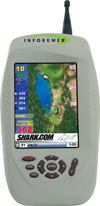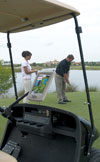

As GPS technology gets better and better and smaller and smaller it will be able to be used for many things? For instance, at the World Series, a baseball hit into the third level will be able to be recorded by GPS as to exactly how far it was hit and its trajectory to formulate where it would have actually landed had the stadium been flat.
Thus we will be able to tell who was the greatest homerun powerhouse of all times, perhaps even who is on steroids, based on their body mass, speed of pitch, GPS data and 'haptics' (body movement and form).
Would it not be cool to be watching the World Series on TV and instant information about a homerun appearing on the bottom of the screen? Sounds like a whole new potential betting arena, not only how many homeruns a person will hit, but exactly how far they will hit them?
A football kick would be immediately known: the exact yardage, every play near the sidelines could be instantly called in/out-of-bounds and there would never be any question as to if a football actually broke the goal line. I can hear the referee unions screaming foul already as they will no longer be needed or have jobs. Ouch - soccer balls, off sides, out of bounds? Yes, all possible via GPS data.
Era of ultra-miniaturisation
With sensors getting smaller and GPS units being used in unmanned aerial vehicles becoming smaller and smaller for micro-air-vehicles and RFID imbedded chips, this technology, believe it or not, is ready for golf balls as well. All one needs is a little imagination. Tiger Woods could have a PDA device in his hands which measures exactly where the ball is, how far to the next hole, by picking up the data from inside the golf ball itself and the flag at the hole. Way-points are displayed also as to where the sand traps are, lakes, edge of fairway and the rough surrounding the green.

The World Think Tank's (www.worldthinktank.com) recent discussion and brain-storming session digressed from GPS navigational devices to sports and we came up with the idea to put GPS sensors in golf balls, so you could find your golf ball if you have a nasty slice, or heavy winds take it off course. Part of our discussion also came from another recent think tank discussion on putting GPS sensors on swarms of locusts in order to track them.
The idea of putting GPS sensors on locusts is a noble idea, but who will pay for this technology, as the locust is small and cannot carry much weight and must still keep up with the rest of the swarm. This of course, would throw off the reading. Our thoughts were to let the golfing community pay for it. After all, if the locusts see such a green area of grass they would eat it all up.
As a kid I used to run on the golf course and saw balls 'way off' the ranges and fairways. Some of these golf balls were custom, with people's names on them. Adding insult to injury - ouch - I could immediately tell who the bad golfer was. With the new GPS WTT Golf Balls you could never lose your golf balls, because you would know their exact location via a set of satellites and that data would be displayed on your wireless PDA device. This PDA wireless tracking device would be with you and you could carry it in a zipper pouch on the golf bag or on the steering wheel of your golf cart. On the poles and flags of each hole would be another sensor so when you set the ball on the tee for the next shot, you would see the exact distance.
We went one step further and figured out how to integrate a mini-weather station system on a golf cart. It will be a slight modification of the Climatronics' TACMET System. For those who liked to get a work out, it could be integrated into the golf bag with a small external periscope. By integrating the GPS system with known GIS golf course topography and exact weather readings from the TACMET System into the wireless PDA, the golfer would have all the data needed to make a perfect shot provided they had the skill and pre-cognitive ability to make it so. Our system will also be able to suggest the best club to use, based on the ability of the golfer from previous courses, wind, distance and punching in of the golfer's present fatigue factor based on a 1-10 scale.
A Florida company, Great White Shark Entertainment is already busy installing WiFi and GPS systems such as golf shot distance measurement and course information, which includes a golf cart mounted system and handheld PDA wireless mobile display. These systems will become great revenue enhancers for golf clubs and for the serious golfer who likes all the bells and whistles and has the money to afford them. Their system is quite perfect to add to our idea or vice versa: see the 'Inforemer' at www.gpsindustries.com
The WTT GPS Golf Balls will be more expensive than normal balls but well worth it as the system teaches the player to shoot a better game. The golf ball could be the same weight as any normal PGA golf ball.
Future?
A future thought along this theme, would be to eventually have, through special internal parts and 'shape-shifting' techniques, a ball that, if it got close to the hole, would simply roll itself over to the hole and fall in. This would mean no one would ever have to give a free put, or allow someone to feel bad who fudged the score. This future idea would be great for the player who understands he is not anywhere near a scratch golfer but occasionally might like to play with a few. Or for the player who goes to the course simply to look cool, but has not the brains or talent!
For more information contact Andrew Gabe, [email protected], www.gpsinfoguide.com

© Technews Publishing (Pty) Ltd | All Rights Reserved